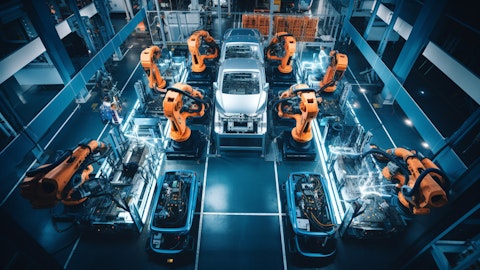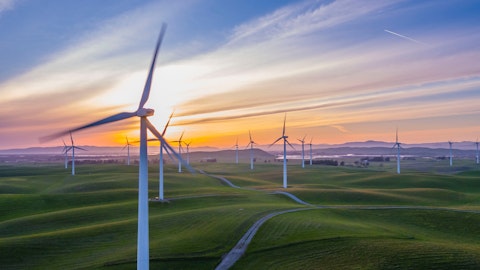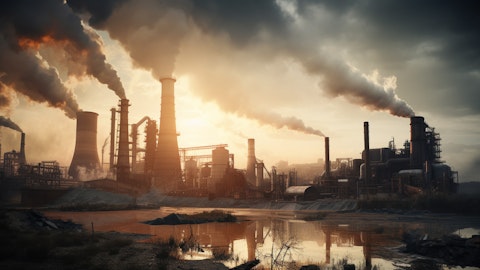Eric Stine: Got it. And I mean, is it something where you have a kind of a specific goal you think exiting — exiting fiscal 2024, your product backlog is this? I mean, certainly, you anticipate growth, but is this more of a setting the stage for 2025, 2026, 2027 or do you think that at the end of 2024, you could have a decent amount of product backlog?
Jason Few: Look, we certainly have a target relative to backlog, and building our backlog throughout the fiscal calendar year for us of 2024. And we think these opportunities will play into that. We think repowering is one of those opportunities. And as we’ve seen just here recently, the opportunities with our solid oxide platform, and we talked about last quarter, which we’re working through contractual terms on a commercial win around leveraging our platform for biofuels in California. And we think with the growing Biofuel Market, our R&D and our ability to take direct biofuels, again, positions us really well to start turning this pipeline and to close transactions throughout 2024.
Eric Stine: Got it. Thank you. And then maybe just the last one here, and I’m not sure, I think last quarter, you might have provided some specifics. But clearly, now given the setup in South Korea, there is a big opportunity on the service side, any specifics in terms of kind of near-term visibility pipeline? Any details would be great.
Mark Feasel: Yeah. So we are — if you step back and look at our opportunity in Korea with respect to repowering, we directly sold the opportunity at Costco. And so that one is one that we continue to manage, as we always have under our framework of a long-term service agreement. We’ve successfully now been able to repower Noeul Green, which was a project that was sold by our previous partner in the Korea market. And now as those modules came up for replacement or upgrading those modules, we were able to do that and now have the long-term service agreement for that opportunity. We see the balance of the Genco’s that have our platforms deployed, so call it, 100 megawatts of opportunity as repowering opportunity for us as a company.
Now we need to go execute those agreements and come the agreement on LTSAs on a go-forward basis for those opportunities. But those translate into two things for us. One, its new module sales, because we need to upgrade those modules as part of the repowering and a new long-term service agreement that goes along with those modules that run curtailment, if you will, with those modules. So we see that as a real market opportunity for us. And Mark and his team, is very focused on the repowering opportunity in Korea.
Eric Stine: Okay. Thank you.
Jason Few: Thank you.
Operator: Our next question comes from Ryan Pfingst from B Riley. Your line is now open.
Ryan Pfingst: Hey good morning guys.
Jason Few: Good morning.
Ryan Pfingst: First question is around OpEx. Just wondering how we should think about R&D going forward, as we get closer to commercialization on some of the next-gen tech, does that start to trend lower year-over-year in 2025, maybe up year-over-year this year?
Mike Bishop: Good morning, Ryan, this is Mike. I’ll take that question, and thank you for joining the call. So as far as R&D, you have seen it trend up over the last several years, and this is really related to the commercialization efforts that the company is putting into our solid oxide platform, as Jason mentioned, around power gen and electrolysis as well as carbon capture. So it has trended up the targets that we put out for this year were between $60 million and $70 million for that line. So we’re right in that range kind of at the lower end of that range. So I wouldn’t expect to see a material increase from where we sit today.
Ryan Pfingst: That’s helpful. And my second question is, do you have an update on the potential DOE loan guarantee or maybe any sense of timing that you can help us with there?
Mike Bishop: Yes. So we are — where we look to leverage the DOE loan program opportunity is in two potential areas. One is around expanding our capacity for solid oxide in North America. And as we talked about, we’ve been doing the work to identify potential new locations, which also may include additional expansion capacity at our existing facility here in Torrington, which would also be eligible for the DOE loan guarantee, if we go that route. The other area is ultimately what we end up doing around expansion of our carbonate platform tied to ultimately, our view of the carbon capture opportunity. So now there’s about a four-phase process that you go through with the DOE. And we are progressing through that process but don’t have a specific answer on timing of closure of that as we sit here today.
Ryan Pfingst: Got it. Thank you. I’ll turn it back
Mike Bishop: Thank you.
Operator: Our next question comes from Noel Parks from Touhy Brothers. Your line is now open.
Noel Parks: Hi, good morning. I apologize if you touched on this earlier. I got on a little late. But I wondered if you could talk a bit about the ExxonMobil partnership and sort of announced that they sort of formalized making carbon capture technology of choice. And so if you could just talk about maybe the pace of further developments from here as you look ahead?
Jason Few: Yes. Good morning. Noel, how are you doing this morning?
Noel Parks: Great. Thanks.
Jason Few: Yes. So as we announced, that we have reached a point in the work that we’ve been doing with Exxon to move forward on the Rotterdam demonstration project at one of their facilities. And so the team is working on building the platform and support of that demonstration effort with Exxon. We remain very excited about the opportunity around carbon capture. But the current focus right now is really around the demonstration effort and getting that platform built and ultimately building the demonstration project. And we — in February, we also put out an announcement around the funding of the order in support of that demonstration project. So we’re continuing to advance the program.




